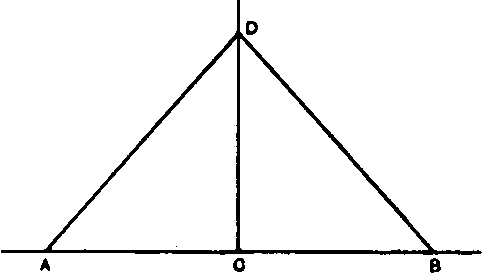Lining And Spacing
Description
This section is from the book "Rubber And Rubber Planting", by R. H. Lock. Also available from Amazon: Rubber And Rubber Planting.
Lining And Spacing
The positions of the holes in which the trees will be planted must next be marked out in lines at right angles to a given base. It is important that these lines should be laid out accurately in order to allow of an uninterrupted view through the estate. If the first line is laid out accurately, others can readily be placed by simple measurement. A method of placing a line at right angles to a base line is shown in the diagram. If AC is made equal to BC and AD to BD the line CD will be at right angles to the line AB.
The distance at which the trees should be spaced is a matter which has given rise to much discussion. The distances generally favoured in the Malay Peninsula give an average of about 150 trees to the acre, whilst in Ceylon the average number is much nearer 200 to the acre. Although different distances are suitable for different soils and situations, it is generally agreed that these numbers are too large for permanent plantations and lead to excessive crowding by about the tenth year. For future planting a distance of 15 x 15 feet may probably be regarded as the absolute minimum, giving nearly 200 trees to the acre without allowing for casualties. Such a distance must ultimately lead to crowding. On the other hand, a greater distance will almost certainly entail reduced yields from a given area during the early stages of tapping. Unfortunately there does not appear to be any conclusive evidence yet published from which a comparison can be drawn between the results of such close planting and those of wider planting, as time goes on. A consensus of opinion points to the greater value of a smaller number of larger and less crowded trees; and it is at least probable that the crop will be obtained more cheaply from such a plantation than from one bearing a larger number of more crowded trees of the same age. Twenty trees similar to the largest tree at Henaratgoda 35 years oldówould yield upwards of 1000 lbs. of rubber annually. 600 lbs. per acre is about the most that can be got from trees on similar soil planted 12x12 feet at 25 years of age. The large tree is however probably exceptional, whilst 12x12 feet is certainly too close a distance. In the present state of knowledge it may be thought that a suitable final distance is probably about 30 x 30 feet under average conditions, or 50 trees to the acre.
Where a suitable inter-crop is available, an original planting distance of 30 x 30 feet may probably be recommended. But where rubber is the only cultivation, planting at such a distance means foregoing a considerable amount of profit during the earlier stages. It is therefore not likely that such wide planting will often be adopted in practice. With closer planting the question of thinning out will have to be faced later on. This process will more properly be discussed at a somewhat later stage

Fig 13. Planting Distances.
The distances mentioned in the preceding paragraphs apply to average conditions and may be somewhat increased or reduced according to circumstances. It is convenient to remember that.
Table XXVI
a distance of feet | gives approximately trees per acre | actually trees per acre |
12X12 | 300 | 302 |
15X15 | 200 | 194 |
15X20 | 150 | 145 |
20X20 | 100 | 109 |
30x30 | 50 | 48 |
35X35 | 35 | 35 |
The figures given above apply to planting on the square. By adopting the hexagonal system of planting the distance between any given tree and its nearest neighbours is somewhat increased, keeping the same number of trees per acre. This is probably an advantage during the short period when the lateral branches are just beginning to meet. The method is somewhat more troublesome than the square system and is seldom adopted. The arrangement of the trees on the two systems is shown in Fig. 14.

Square system. Fig. 14. Hexagonal system.
Continue to:
